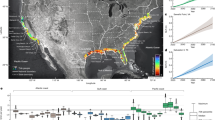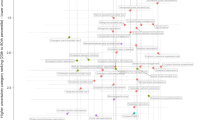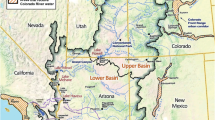Abstract
Against the background of potentially substantial sea-level rise, one important question is to what extent are coastal societies able to adapt? This question is often answered in the negative by referring to sinking islands and submerged megacities. Although these risks are real, the picture is incomplete because it lacks consideration of adaptation. This Perspective explores societies’ abilities to adapt to twenty-first-century sea-level rise by integrating perspectives from coastal engineering, economics, finance and social sciences, and provides a comparative analysis of a set of cases that vary in terms of technological limits, economic and financial barriers to adaptation and social conflicts.
This is a preview of subscription content, access via your institution
Access options
Access Nature and 54 other Nature Portfolio journals
Get Nature+, our best-value online-access subscription
$29.99 / 30 days
cancel any time
Subscribe to this journal
Receive 12 print issues and online access
$209.00 per year
only $17.42 per issue
Buy this article
- Purchase on Springer Link
- Instant access to full article PDF
Prices may be subject to local taxes which are calculated during checkout




Similar content being viewed by others
References
DeConto, R. M. & Pollard, D. Contribution of Antarctica to past and future sea-level rise. Nature 531, 591–597 (2016).
Jevrejeva, S., Grinsted, A. & Moore, J. C. Upper limit for sea level projections by 2100. Environ. Res. Lett. 9, 104008 (2014).
Kopp, R. E. et al. Probabilistic 21st and 22nd century sea-level projections at a global network of tide-gauge sites. Earth’s Future 2, 383–406 (2014).
Bars, D. L., Drijfhout, S. & de Vries, H. A high-end sea level rise probabilistic projection including rapid Antarctic ice sheet mass loss. Environ. Res. Lett. 12, 044013 (2017).
Clark, P. U. et al. Consequences of twenty-first-century policy for multi-millennial climate and sea-level change. Nat. Clim. Change 6, 360–369 (2016).
Church, J. A. et al. in Climate Change 2013: The Physical Science Basis (eds Stocker, T. F. et al.) Ch. 13 (IPCC, Cambridge Univ. Press, 2013).
Kahn, B. Here are 10 striking images of future sea levels. Climate Central (10 July 2015); http://www.climatecentral.org/news/images-of-future-sea-levels-19213
Diaz, D. B. Estimating global damages from sea level rise with the Coastal Impact and Adaptation Model (CIAM). Climatic Change 137, 143–156 (2016).
Hinkel, J. et al. Coastal flood damage and adaptation cost under 21st century sea-level rise. Proc. Natl Acad. Sci. USA 111, 3292–3297 (2014).
Kraus, N. C. History and Heritage of Coastal Engineering (ASCE, Orlando, FL, 1996).
Kaneko, S. & Toyota, T. in Groundwater and Subsurface Environments: Human Impacts in Asian Coastal Cities 249–270 (Springer, Tokyo, 2011).
Adger, W. N. et al. Are there social limits to adaptation to climate change? Climatic Change 93, 335–354 (2009).
Biesbroek, R., Klostermann, J., Termeer, C. & Kabat, P. Barriers to climate change adaptation in the Netherlands. Clim. Law 2, 181–199 (2011).
Eisenack, K. et al. Explaining and overcoming barriers to climate change adaptation. Nat. Clim. Change 4, 867–872 (2014).
Bisaro, A. & Hinkel, J. Mobilizing private finance for coastal adaptation: A literature review. WIREs Clim. Change 9, e514 (2018).
Auerbach, L. W. et al. Flood risk of natural and embanked landscapes on the Ganges-Brahmaputra tidal delta plain. Nat. Clim. Change 5, 153–157 (2015).
Brown, S. & Nicholls, R. J. Subsidence and human influences in mega deltas: the case of the Ganges-Brahmaputra-Meghna. Sci. Total Environ. 527–528, 362–374 (2015).
Amir, M. S. I. I., Khan, M. S. A., Khan, M. M. K., Rasul, M. G. & Akram, F. Tidal River Sediment Management–A Case Study in Southwestern Bangladesh. Int. J. Environ. Chem. Ecol. Geol. Geophys. Eng. 7, 174–185 (2013).
Nowreen, S., Jalal, M. R. & Shah Alam Khan, M. Historical analysis of rationalizing South West coastal polders of Bangladesh. Water Policy 16, 264–279 (2014).
Bangladesh Delta Plan 2100 (General Economics Division of the Ministry of Planning, Government of Bangladesh, 2015).
Darby, S. E., Nicholls, R. J., Rahman, M. M., Brown, S. & Karim, M. R. in Ecosystem Services for Well-Being in Deltas: Integrated Assessment for Policy Analysis (eds Nicholls, R. J. et al.) (Palgrave Macmillan, London, 2017).
Nicholls, R. J. et al. Integrated assessment of social and environmental sustainability dynamics in the Ganges-Brahmaputra-Meghna delta, Bangladesh. Estuar. Coast. Shelf Sci. 183, 370–381 (2016).
Country Profiles: Bangladesh (Global Humanitarian Assistance, 2015); http://www.globalhumanitarianassistance.org/countryprofile/bangladesh
Dewan, C., Mukherji, A. & Buisson, M.-C. Evolution of water management in coastal Bangladesh: from temporary earthen embankments to depoliticized community-managed polders. Water Int. 40, 401–416 (2015).
Paul, B. G. & Vogl, C. R. Impacts of shrimp farming in Bangladesh: challenges and alternatives. Ocean Coast. Manage. 54, 201–211 (2011).
Nicholls, R. J. et al. (eds) Ecosystem Services for Well-Being in Deltas: Integrated Assessment for Policy Analysis (Palgrave Macmillan, London, 2017).
Duró Moreno, J. A. Aproximació a l’Activitat Económica Generada pel Turisme a les Comarques de Catalunya Sêrie 2008–2012 (Departament d’Empresa i Coneixement, Generalitat de Catalunya, 2013).
Jiménez, J. A., Valdemoro, H. I., Bosom, E., Sánchez-Arcilla, A. & Nicholls, R. J. Impacts of sea-level rise-induced erosion on the Catalan coast. Reg. Environ. Change 17, 593–603 (2017).
Alvarado-Aguilar, D., Jiménez, J. A. & Nicholls, R. J. Flood hazard and damage assessment in the Ebro Delta (NW Mediterranean) to relative sea level rise. Nat. Hazards 62, 1301–1321 (2012).
Oltra, A., Del Río, L. & Jiménez, J. A. Sea level rise flood hazard mapping in the Catalan coast (NW Mediterranean). In Proc. CoastGIS 2011 Conf. Vol. 4, 120–126 (Corila, Oostende, 2011).
Jiménez, J. A., Gracia, V., Valdemoro, H. I., Mendoza, E. T. & Sánchez-Arcilla, A. Managing erosion-induced problems in NW Mediterranean urban beaches. Ocean Coast. Manage. 54, 907–918 (2011).
Ariza, E., Jiménez, J. A. & Sardá, R. A critical assessment of beach management on the Catalan coast. Ocean Coast. Manage. 51, 141–160 (2008).
Rigall-I-Torrent, R. et al. The effects of beach characteristics and location with respect to hotel prices. Tour. Manage. 32, 1150–1158 (2011).
González-Correa, J. M., Torquemada, Y. F. & Sánchez Lizaso, J. L. Long-term effect of beach replenishment on natural recovery of shallow Posidonia oceanica meadows. Estuar. Coast. Shelf Sci. 76, 834–844 (2008).
Suárez de Vivero, J. L. & Rodríguez Mateos, J. C. Coastal crisis: the failure of coastal management in the Spanish Mediterranean region. Coast. Manage. 33, 197–214 (2005).
Muñoz, J. M. B. Coastal zone management in Spain (1975–2000). J. Coast. Res. 19, 314–325 (2003).
Ariza, E. An analysis of beach management framework in Spain. Study case: the Catalonian coast. J. Coast. Conserv. 15, 445–455 (2011).
Minh, D., Van Trung, L. & Toan, T. Mapping ground subsidence phenomena in Ho Chi Minh City through the radar interferometry technique using ALOS PALSAR Data. Remote Sens. 7, 8543–8562 (2015).
Phi, H. L., Hermans, L. M., Douven, W. J. A. M., Van Halsema, G. E. & Khan, M. F. A framework to assess plan implementation maturity with an application to flood management in Vietnam. Water Int. 40, 984–1003 (2015).
Climate Adaptation Strategy: Ho Chi Minh City (Vietnam Climate Adaptation PartnerShip, 2013).
Scussolini, P. et al. Adaptation to sea level rise: a multidisciplinary analysis for Ho Chi Minh City, Vietnam. Water Resour. Res. 53, 10841–10857 (2017).
Up a creek. The Economist (4 May 2013).
City protests sea dyke construction. TalkVietnam (27 October 2016); https://m.talkvietnam.org/2016/10/city-protests-sea-dyke-construction
Naylor, A. K. Island morphology, reef resources, and development paths in the Maldives. Progr. Phys. Geogr. 39, 728–749 (2015).
Brown, S. et al. Shifting perspectives on coastal impacts and adaptation. Nat. Clim. Change 4, 752–755 (2014).
Wadey, M., Brown, S., Nicholls, R. J. & Haigh, I. Coastal flooding in the Maldives: an assessment of historic events and their implications. Nat. Hazards 89, 131–159 (2017).
Naish, A. Saudi Arabia grants US$80m loan for Hulhumalé development. Maldives Independen t (14 September 2015).
Maldives Overcoming the Challenges of a Small Island State (Asian Development Bank, 2015)..
Elrick-Barr, C., Glavovic, B. C. & Kay, R. in Climate Change and the Coast 313–336 (CRC Press, 2015).
Naish, A. Population consolidation keystone of 2016 state budget. Maldives Independent (16 November 2015).
Kwadijk, J. C. J. et al. Using adaptation tipping points to prepare for climate change and sea level rise: a case study in the Netherlands. WIREs Clim. Change 1, 729–740 (2010).
Klijn, F., de Bruijn, K. M., Knoop, J. & Kwadijk, J. Assessment of the Netherlands’ flood risk management policy under global change. AMBIO 41, 180–192 (2012).
Delta Programme 2015: Working on the Delta—The Decisions to Keep the Netherlands Safe and Liveable (Ministerie van Infrastructuur en Milieu, 2014).
Lenderink, G., Buishand, A. & van Deursen, W. Estimates of future discharges of the river Rhine using two scenario methodologies: direct versus delta approach. Hydrol. Earth Syst. Sci. 11, 1145–1159 (2007).
Olsthoorn, X., van der Werff, P., Bouwer, L. M. & Huitema, D. Neo-Atlantis: The Netherlands under a 5-m sea level rise. Climatic Change 91, 103–122 (2008).
Aandacht voor Veiligheid (Leven met Water, Klimaat voor Ruimte, DG Water, 2008).
H. Stolwijk. Ruimte Voor Water : Kosten en Baten van zes Projecten en Enige Alternatieven 79 (Centraal Planbureau, 2000).
Kabat, P. et al. Dutch coasts in transition. Nat. Geosci. 2, 450–452 (2009).
Kind, J. M. Economically efficient flood protection standards for the Netherlands: efficient flood protection standards for the Netherlands. J. Flood Risk Manage. 7, 103–117 (2014).
van Staveren, M. F., Warner, J. F., van Tatenhove, J. P. M. & Wester, P. Let’s bring in the floods: de-poldering in the Netherlands as a strategy for long-term delta survival? Water Int. 39, 686–700 (2014).
Tol, R. S. J. et al. Adaptation to five metres of sea level rise. J. Risk Res. 9, 467–482 (2006).
Aerts, J. C. J. H., Botzen, W. J. W., de Moel, H. & Bowman, M. Cost estimates for flood resilience and protection strategies in New York City: flood management strategies for New York City. Ann. NY Acad. Sci. 1294, 1–104 (2013).
A Stronger, More Resilient New York (New York Special Initiative for Rebuilding and Resilience, 2013).
Jonkman, S. N., Hillen, M. M., Nicholls, R. J., Kanning, W. & van Ledden, M. Costs of adapting coastal defences to sea-level rise — new estimates and their implications. J. Coast. Res. 29, 1212–1226 (2013).
Aerts, J. C. J. H. et al. Evaluating flood resilience strategies for coastal megacities. Science 344, 473–475 (2014).
NYC Community Development Block Grant Disaster Recovery: HUD Quarterly Reports (Office of the Mayor, NYC Recovery, 2017).
Aerts, J. C. J. H. & Botzen, W. J. W. Flood-resilient waterfront development in New York City: bridging flood insurance, building codes, and flood zoning. Ann. NY Acad. Sci. 1227, 1–82 (2011).
Botzen, W. J. W., Michel-Kerjan, E., Kunreuther, H., de Moel, H. & Aerts, J. C. J. H. Political affiliation affects adaptation to climate risks: evidence from New York City. Climatic Change 138, 353–360 (2016).
Bloetscher, F., Heimlich, B. & Meeroff, D. E. Development of an adaptation toolbox to protect southeast Florida water supplies from climate change. Environ. Rev. 19, 397–418 (2011).
Nicholls, R. J. in Understanding Sea-Level Rise and Variability (eds Church, J. A. et al.) 17–51 (Wiley-Blackwell, Oxford, 2010).
De Bruijn, K. M., Klijn, F. & Knoeff, J. G. in Comprehensive Flood Risk Management: Research for Policy and Practice 19–23 (Taylor & Francis Group, London, 2013).
Kirwan, M. L. & Megonigal, J. P. Tidal wetland stability in the face of human impacts and sea-level rise. Nature 504, 53–60 (2013).
Cheong, S.-M. et al. Coastal adaptation with ecological engineering. Nat. Clim. Change 3, 787–791 (2013).
Duarte, C. M., Losada, I. J., Hendriks, I. E., Mazarrasa, I. & Marbà, N. The role of coastal plant communities for climate change mitigation and adaptation. Nat. Clim. Change 3, 961–968 (2013).
Wang, W., Liu, H., Li, Y. & Su, J. Development and management of land reclamation in China. Ocean Coast. Manage. 102, 415–425 (2014).
Pascal, P. Sand rarer than one thinks. Environ. Dev. 11, 208–218 (2014).
Appeaning Addo, K. Monitoring sea level rise-induced hazards along the coast of Accra in Ghana. Nat. Hazards 78, 1293–1307 (2015).
Klein, R. J. T. et al. in Climate Change 2014: Impacts, Adaptation, and Vulnerability (eds Field, C. B. et al.) 899–943 (IPCC, Cambridge Univ. Press, 2014).
Linham, M. M. & Nicholls, R. J. Technologies for Climate Change Adaptation—Coastal Erosion and Flooding (UNEP Riso Centre on Energy and Climate and Sustainable Development, 2010).
The New Orleans Hurricane Protection System: What Went Wrong and Why: A Report (ASCE, 2007).
Hinkel, J. “Indicators of vulnerability and adaptive capacity”: towards a clarification of the science–policy interface. Glob. Environ. Change 21, 198–208 (2011).
Fostering Investment in Infrastructure: Lessons Learned from OECD Investment Policy Reviews (OECD, 2015).
The Adaptation Finance Gap Report 2016 (United Nations Environment Programme, 2016).
Hino, M., Field, C. B. & Mach, K. J. Managed retreat as a response to natural hazard risk. Nat. Clim. Change 7, 364–370 (2017).
Temmerman, S. et al. Ecosystem-based coastal defence in the face of global change. Nature 504, 79–83 (2013).
GPWv4: Population Density Adjusted to Match 2015 Revision of UN WPP Country Totals (CIESIN, Columbia Univ., 2016); https://doi.org/10.7927/H4HX19NJ
Jarvis, A., Reuter, H. I, Nelson, A. & Guevara, E. Hole-filled SRTM for the Globe version 4 (CGIAR Consortium for Spatial Information, 2008).
Nicholls, R. J. et al. in Climate Change 2007: Impacts, Adaptation, and Vulnerability (eds Parry, M. L. et al.) 315–356 (IPCC, Cambridge Univ. Press, 2007).
Dow, K. et al. Limits to adaptation. Nat. Clim. Change 3, 305–307 (2013).
Moser, S. C. & Ekstrom, J. A. A framework to diagnose barriers to climate change adaptation. Proc. Natl Acad. Sci. USA 107, 22026–22031 (2010).
Ekstrom, J. A. & Moser, S. C. Identifying and overcoming barriers in urban climate adaptation: Case study findings from the San Francisco Bay Area, California, USA. Urban Clim. 9, 54–74 (2014).
Wong, P. P. et al. in Climate Change 2014: Impacts, Adaptation, and Vulnerability (eds Field, C. B. et al.) 361–409 (IPCC, Cambridge Univ. Press, 2014).
Hayward, T. Climate change and ethics. Nat. Clim. Change 2, 843–848 (2012).
Weitzman, M. L. A review of “The Stern Review on the Economics of Climate Change”. J. Econ. Lit. 45, 703–724 (2007).
Weisbach, D. & Sunstein, C. R. Climate change and discounting the future: a guide for the perplexed. Yale Law Policy Rev. 27, 433–457 (2009).
Chambwera, M. et al. in Climate Change 2014: Impacts, Adaptation, and Vulnerability (eds Field, C. B. et al.) Ch. 17 (IPCC, Cambridge Univ. Press, 2014).
Kunreuther, H. et al. in Climate Change 2014: Mitigation of Climate Change (eds Edenhofer, O. et al.) Ch. 2 (IPCC, Cambridge Univ. Press, 2014).
Ostrom, E. Understanding Institutional Diversity (Princeton Univ. Press, Princeton, NJ, 2005).
Nyborg, K. et al. Social norms as solutions. Science 354, 42–43 (2016).
Williamson, O. E. The new institutional economics: taking stock, looking ahead. J. Econ. Lit. 38, 595–613 (2000).
Bisaro, A. & Hinkel, J. Governance of social dilemmas in climate change adaptation. Nat. Clim. Change 6, 354–359 (2016).
Knight, J. Institutions and Social Conflict (Cambridge Univ. Press, Cambridge, 1992).
Acknowledgements
J.H., J.C.J.H.A., S.B., J.A.J., D.L., R.J.N., P.S., A.S.A. and A.V. received funding from the European Union’s Seventh Framework Programme for Research, Technological Development and Demonstration under grant agreement no 603396 (RISES-AM project). J.H. and D.L. also received funding from the European Union’s Horizon 2020 Research and Innovation Programme under grant agreement no. 642018 (GREEN-WIN project) and from the DFG under the SEASCAPE project as part of the Special Priority Program (SPP)-1889 "Regional Sea Level Change and Society" (SeaLevel). J.C.J.H.A. also received funding from Dutch Science foundation VICI grant no. 453-13-006. J.A.J. was also funded by the Spanish Ministry of Economy and Competitiveness project PaiRisClima (CGL2014-55387-R). We thank J. Merkens for providing the values included in Table 1. We also thank A. Shareef and Z. Khaleel from the Ministry of Environment and Energy for extended discussions about adapting to SLR in the Maldives.
Author information
Authors and Affiliations
Contributions
J.H. conceived this study, drafted the general sections of the paper and contributed to drafting each case study. J.C.J.H.A. carried out and drafted the New York case study. S.B., D.L., R.J.N. and J.H. carried out and drafted the Maldives case study. R.J.N. and S.B. carried out and drafted the Bangladesh case study. J.A.J. and A.S.A. carried out and drafted the Catalonia case study. P.S. carried out and drafted the Ho Chi Minh City case study. P.S. and J.C.J.H.A. carried out and drafted the Netherlands case study. K.A.A. and N.V. contributed to the drafting the discussion.
Corresponding author
Ethics declarations
Competing interests
The authors declare no competing interests.
Additional information
Publisher’s note: Springer Nature remains neutral with regard to jurisdictional claims in published maps and institutional affiliations.
Rights and permissions
About this article
Cite this article
Hinkel, J., Aerts, J.C.J.H., Brown, S. et al. The ability of societies to adapt to twenty-first-century sea-level rise. Nature Clim Change 8, 570–578 (2018). https://doi.org/10.1038/s41558-018-0176-z
Received:
Accepted:
Published:
Issue Date:
DOI: https://doi.org/10.1038/s41558-018-0176-z
This article is cited by
-
Beyond inundation: a comprehensive assessment of sea level rise impact on coastal cultural heritage in China
Heritage Science (2024)
-
Financial constraints and short-term planning are linked to flood risk adaptation gaps in US cities
Communications Earth & Environment (2024)
-
Social consequences of planned relocation in response to sea level rise: impacts on anxiety, well-being, and perceived safety
Scientific Reports (2024)
-
Place attachment, storms, and climate change in the Faroe Islands
Regional Environmental Change (2024)
-
Habitability of low-lying socio-ecological systems under a changing climate
Climatic Change (2024)



